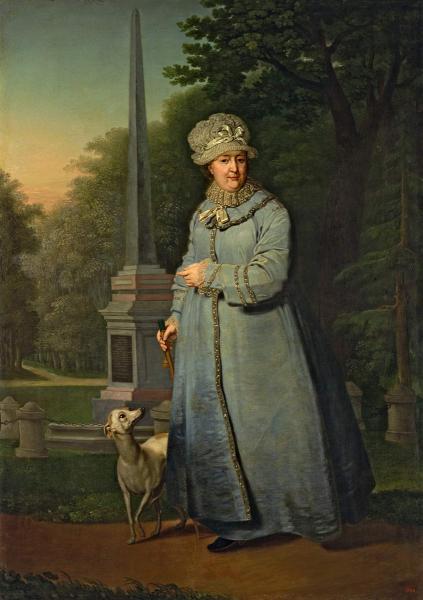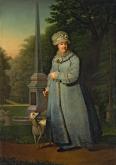Catherine II Promenading in the Tsarskoye Selo Park (With the Obelisk to Count Pyotr Rumyantsev's Victories in the Background)
Late 1800s — early 1810s
- oil on canvas. 99 х 68
- Ж-5008
Пост. в 1908 в дар от великой княгини Елизаветы Федоровны (Москва); ранее — в собр. великого князя Сергея Александровича (Москва); ранее (с 1899 (1900?) — у апраксинодворского торговца Кузнецова (Санкт-Петербург); ранее (с 1844) — у князя М. С. Воронцова (Санкт-Петербург); ранее (в 1837) — у князя А. Н. Голицына (Санкт-Петербург); ранее (с 1826) — у графа С. П. Румянцева (Санкт-Петербург); ранее (в начале XIX в.) — у графа Н. П. Румянцева (Санкт-Петербург)
Empress Catherine II (the Great; 1729–1796), née Sophie Friederike Auguste von Anhalt-Zerbst-Dornburg, was born in the Prussian city of Stettin. In 1744, she arrived in Russia as the bride of Grand Duke Peter Feodorovich, the future Emperor Peter III. That same year, she converted to Russian Orthodoxy and took the name Catherine Alexeyevna. She married Peter Feodorovich in August 1745. In 1754 she gave birth to an heir, the future Emperor Paul I. The relationship with her husband did not work out, and he planned to have her sent to a convent. In the summer of 1762 she led a conspiracy of Peter’s guards and overthrew him, becoming Empress. In the first years of her reign she adhered to a policy of “enlightened absolutism”, but after the peasant rebellion led by Emelyan Pugachev (1773–1775) and the French Revolution (1789), she was forced to toughen her regime. She led victorious campaigns against Turkey (1768–1774; 1787–1792) and Sweden (1788–1790). During her reign, the Crimea (1783), the Northern Baltic Sea, the Baltic states, the eastern part of Poland, and the Aleutian Islands became part of Russia. Russian settlements were established in Alaska, and Eastern Georgia was taken under the protection of Russia. Russia’s prestige in Europe increased greatly.
Borovikovsky did not have the possibility to paint a portrait from life, and when he painted Empress Catherine II, it was the lady in waiting of the Empress, Maria Perekusikhina, who posed. The first version of this portrait (with the Chesme Column in the background) was made in 1794 and is displayed at the Tretyakov Gallery. This portrait was then engraved by Nikolai Utkin in 1827.

